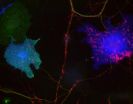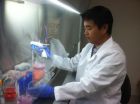(Press-News.org) Scientists at Arizona State University are celebrating their recent success on the path to understanding what makes the fiber that spiders spin – weight for weight - at least five times as strong as piano wire. They have found a way to obtain a wide variety of elastic properties of the silk of several intact spiders' webs using a sophisticated but non–invasive laser light scattering technique.
"Spider silk has a unique combination of mechanical strength and elasticity that make it one of the toughest materials we know," said Professor Jeffery Yarger of ASU's Department of Chemistry and Biochemistry, and lead researcher of the study. "This work represents the most complete understanding we have of the underlying mechanical properties of spider silks."
Spider silk is an exceptional biological polymer, related to collagen (the stuff of skin and bones) but much more complex in its structure. The ASU team of chemists is studying its molecular structure in an effort to produce materials ranging from bulletproof vests to artificial tendons.
The extensive array of elastic and mechanical properties of spider silks in situ, obtained by the ASU team, is the first of its kind and will greatly facilitate future modeling efforts aimed at understanding the interplay of the mechanical properties and the molecular structure of silk used to produce spider webs.
The team published their results in today's advanced online issue of Nature materials and their paper is titled "Non-invasive determination of the complete elastic moduli of spider silks."
"This information should help provide a blueprint for structural engineering of an abundant array of bio-inspired materials, such as precise materials engineering of synthetic fibers to create stronger, stretchier, and more elastic materials," explained Yarger.
Other members of Yarger's team, in ASU's College of Liberal Arts and Sciences, included Kristie Koski, at the time a postdoctoral researcher and currently a postdoctoral fellow at Stanford University, and ASU undergraduate students Paul Akhenblit and Keri McKiernan.
The Brillouin light scattering technique used an extremely low power laser, less than 3.5 milliwatts, which is significantly less than the average laser pointer. Recording what happened to this laser beam as it passed through the intact spider webs enabled the researchers to spatially map the elastic stiffnesses of each web without deforming or disrupting it. This non-invasive, non-contact measurement produced findings showing variations among discrete fibers, junctions and glue spots.
Four different types of spider's webs were studied. They included Nephila clavipes (pictured), A. aurantia ("gilded silver face"-common to the contiguous United States), L. Hesperus the western black widow and P. viridans the green lynx spider, the only spider included that does not build a web for catching prey but has major silk elastic properties similar to those of the other species studied.
The group also investigated one of the most studied aspects of orb-weaving dragline spider silk, namely supercontraction, a property unique to silk. Spider silk takes up water when exposed to high humidity. Absorbed water leads to shrinkage in an unrestrained fiber up to 50 percent shrinkage with 100 percent humidity in N. clavipes silk.
Their results are consistent with the hypothesis that supercontraction helps the spider tailor the properties of the silk during spinning. This type of behavior, specifically adjusting mechanical properties by simply adjusting water content, is inspirational from a bio-inspired mechanical structure perspective.
"This study is unique in that we can extract all the elastic properties of spider silk that cannot and have not been measured with conventional testing," concluded Yarger.
INFORMATION:
Source:
Jeffery Yarger, jyarger@gmail.com
Phone: (480)965-0673
ASU scientists unravel the mysteries of spider silk
2013-01-28
ELSE PRESS RELEASES FROM THIS DATE:
Singapore scientists led by A*STAR's GIS identify 4 mechanisms that contribute to gastric cancers
2013-01-28
Scientists at A*STAR's Genome Institute of Singapore (GIS) headed a study that discovered four processes by which gastric cancer is formed. This is extremely important since gastric cancer is the second most common cause of cancer deaths worldwide, claiming almost 750,000 lives annually, 60% of which are Asians.
Using what is known as next-generation sequencing technologies, GIS scientists were able to provide a comprehensive view of the gastric cancer genome, characterizing micro- and macro-scale mutations. This led to the identification of four distinct processes that ...
Dual-hormone artificial pancreas is a step closer for patients with Type 1 diabetes
2013-01-28
For patients with type 1 diabetes, a dual-hormone artificial pancreas system (also known as a closed-loop delivery system) improved the control of glucose levels and reduced the risk of hypoglycemia compared with conventional pump treatment in a trial published in CMAJ (Canadian Medical Association Journal).
It is challenging for patients with type 1 diabetes to control their glucose levels because tight glucose control increases the incidence of hypoglycemia (dangerously low glucose levels). Insulin pump treatment, which provides a continuous predetermined subcutaneous ...
Clinical trials with nonblinded outcome assessors have high observer bias
2013-01-28
A new study of randomized clinical trials found significant observer bias toward a more beneficial treatment effect in nonblinded trials when the researcher knew the treatment being given to the participant. The study is published in CMAJ (Canadian Medical Association Journal).
"Nonblinded assessors of subjective measurement scales outcomes in randomized clinical trials tended to generate substantially biased effect sizes," writes Dr. Asbjørn Hróbjartsson, The Nordic Cochrane Centre, Rigshospitalet Department, Copenhagen, Denmark, with coauthors.
Danish and French researchers ...
Blood pressure, cholesterol most important indicators of heart disease risk in diabetics
2013-01-28
PORTLAND, Ore., January 28, 2013—For people with diabetes, meeting the recommended guidelines for blood pressure and cholesterol is even more important than meeting the guidelines for blood sugar control in reducing the risk of heart attack or stroke, according to a new Kaiser Permanente study published today in the Journal of General Internal Medicine.
The study included more than 26,000 patients with diabetes. Patients who met guidelines for all three risk factors and those who met the blood pressure and cholesterol guidelines were least likely to be hospitalized for ...
Treating constipation in seniors: A review of current treatments
2013-01-28
For seniors who are constipated, the use of polyethylene glycol and lactulose are effective, according to a review of current treatments published in CMAJ (Canadian Medical Association Journal). The article reviews the latest evidence on the efficacy and safety of treatments to help doctors treat their patients.
Constipation, which increases with age, is a common complaint in seniors that can have serious health consequences and affect quality of life. Excessive straining in frail people can cause fainting and the risk of injury from falling or restrict blood flow to ...
Primates too can move in unison
2013-01-28
Japanese researchers show for the first time that primates modify their body movements to be in tune with others, just like humans do. Humans unconsciously modify their movements to be in synchrony with their peers. For example, we adapt our pace to walk in step or clap in unison at the end of a concert. This phenomenon is thought to reflect bonding and facilitate human interaction. Researchers from the RIKEN Brain Science Institute report today that pairs of macaque monkeys also spontaneously coordinate their movements to reach synchrony.
This research opens the door ...
Misconceptions about a popular pet treat
2013-01-28
GRAFTON, Mass. (January 28, 2013)—A popular dog treat could be adding more calories than pet owners realize, and possibly be contaminated by bacteria, according to a study published this month by researchers at the Cummings School of Veterinary Medicine at Tufts University and the University of Guelph.
The treat in question: the "bully" or "pizzle stick." The American and Canadian researchers analyzed the caloric density and bacterial contamination of these popular items, made from the uncooked, dried penis of a bull or steer. They also administered a survey to pet owners ...
Protein family linked to autism suppresses the development of inhibitory synapses
2013-01-28
Synapse development is promoted by a variety of cell adhesion molecules that connect neurons and organize synaptic proteins. Many of these adhesion molecules are linked to neurodevelopmental disorders; mutations in neuroligin and neurexin proteins, for example, are associated with autism and schizophrenia. According to a study in The Journal of Cell Biology, another family of proteins linked to these disorders regulates the function of neuroligins and neurexins in order to suppress the development of inhibitory synapses.
Like neurexins and neuroligins, the neuronal proteins ...
DNA-repairing protein may be key to preventing recurrence of some cancers
2013-01-28
Just as the body can become resistant to antibiotics, certain methods of killing cancer tumors can end up creating resistant tumor cells. But a University of Central Florida professor has found a protein present in several types of cancer, including breast and ovarian cancer, which could be helpful in preventing tumors from coming back.
The protein, KLF8, appears to protect tumor cells from drugs aimed at killing them and even aid the tumor cells' ability to regenerate.
"All cells have a DNA-repair mechanism," explained Jihe Zhao, a medical doctor and researcher who ...
Global research team decodes genome sequence of 90 chickpea lines
2013-01-28
Hyderabad, India, and Shenzhen, China (28 January 2013) – In a scientific breakthrough that promises improved grain yields and quality, greater drought tolerance and disease resistance, and enhanced genetic diversity, a global research team has completed high-quality sequencing of not one but ninety genomes of chickpea.
Nature Biotechnology, the highest ranked journal in the area of biotechnology, featured the reference genome of the CDC Frontier chickpea variety and genome sequence of 90 cultivated and wild genotypes from 10 different countries, as an online publication ...



